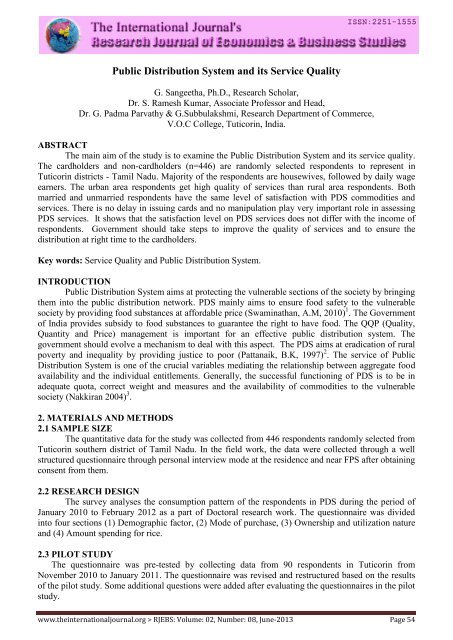Research Journal of Economics & Business Studies - RJEBS - The ...
Research Journal of Economics & Business Studies - RJEBS - The ...
Research Journal of Economics & Business Studies - RJEBS - The ...
- No tags were found...
Create successful ePaper yourself
Turn your PDF publications into a flip-book with our unique Google optimized e-Paper software.
Public Distribution System and its Service Quality<br />
G. Sangeetha, Ph.D., <strong>Research</strong> Scholar,<br />
Dr. S. Ramesh Kumar, Associate Pr<strong>of</strong>essor and Head,<br />
Dr. G. Padma Parvathy & G.Subbulakshmi, <strong>Research</strong> Department <strong>of</strong> Commerce,<br />
V.O.C College, Tuticorin, India.<br />
ABSTRACT<br />
<strong>The</strong> main aim <strong>of</strong> the study is to examine the Public Distribution System and its service quality.<br />
<strong>The</strong> cardholders and non-cardholders (n=446) are randomly selected respondents to represent in<br />
Tuticorin districts - Tamil Nadu. Majority <strong>of</strong> the respondents are housewives, followed by daily wage<br />
earners. <strong>The</strong> urban area respondents get high quality <strong>of</strong> services than rural area respondents. Both<br />
married and unmarried respondents have the same level <strong>of</strong> satisfaction with PDS commodities and<br />
services. <strong>The</strong>re is no delay in issuing cards and no manipulation play very important role in assessing<br />
PDS services. It shows that the satisfaction level on PDS services does not differ with the income <strong>of</strong><br />
respondents. Government should take steps to improve the quality <strong>of</strong> services and to ensure the<br />
distribution at right time to the cardholders.<br />
Key words: Service Quality and Public Distribution System.<br />
INTRODUCTION<br />
Public Distribution System aims at protecting the vulnerable sections <strong>of</strong> the society by bringing<br />
them into the public distribution network. PDS mainly aims to ensure food safety to the vulnerable<br />
society by providing food substances at affordable price (Swaminathan, A.M, 2010) 1 . <strong>The</strong> Government<br />
<strong>of</strong> India provides subsidy to food substances to guarantee the right to have food. <strong>The</strong> QQP (Quality,<br />
Quantity and Price) management is important for an effective public distribution system. <strong>The</strong><br />
government should evolve a mechanism to deal with this aspect. <strong>The</strong> PDS aims at eradication <strong>of</strong> rural<br />
poverty and inequality by providing justice to poor (Pattanaik, B.K, 1997) 2 . <strong>The</strong> service <strong>of</strong> Public<br />
Distribution System is one <strong>of</strong> the crucial variables mediating the relationship between aggregate food<br />
availability and the individual entitlements. Generally, the successful functioning <strong>of</strong> PDS is to be in<br />
adequate quota, correct weight and measures and the availability <strong>of</strong> commodities to the vulnerable<br />
society (Nakkiran 2004) 3 .<br />
2. MATERIALS AND METHODS<br />
2.1 SAMPLE SIZE<br />
<strong>The</strong> quantitative data for the study was collected from 446 respondents randomly selected from<br />
Tuticorin southern district <strong>of</strong> Tamil Nadu. In the field work, the data were collected through a well<br />
structured questionnaire through personal interview mode at the residence and near FPS after obtaining<br />
consent from them.<br />
2.2 RESEARCH DESIGN<br />
<strong>The</strong> survey analyses the consumption pattern <strong>of</strong> the respondents in PDS during the period <strong>of</strong><br />
January 2010 to February 2012 as a part <strong>of</strong> Doctoral research work. <strong>The</strong> questionnaire was divided<br />
into four sections (1) Demographic factor, (2) Mode <strong>of</strong> purchase, (3) Ownership and utilization nature<br />
and (4) Amount spending for rice.<br />
2.3 PILOT STUDY<br />
<strong>The</strong> questionnaire was pre-tested by collecting data from 90 respondents in Tuticorin from<br />
November 2010 to January 2011. <strong>The</strong> questionnaire was revised and restructured based on the results<br />
<strong>of</strong> the pilot study. Some additional questions were added after evaluating the questionnaires in the pilot<br />
study.<br />
www.theinternationaljournal.org > <strong>RJEBS</strong>: Volume: 02, Number: 08, June-2013 Page 54

















